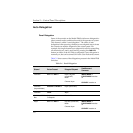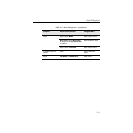
2-14
Section 2— Control Panel Descriptions
Activating the KEY 1 or KEY 2 button (lamp lit) causes the next
transition to bring on or remove the selected key. Selecting KEY 1
or KEY 2 delegates the keyers subpanel and KEY bus to the
selected keyer so that the characteristics of the selected key may be
adjusted (see keyer subpanel description).
One or both of the KEY buttons can be activated at the same time
and one or both keys can be on (ON indicator lit) at the same time.
Pressing KEY PRIORity causes the next transition to swap the Key
1/Key 2 priority. This can be performed as a mix, wipe, or cut
transition. Key priority always involves both Key 1 and Key 2
The OVER indicators lights when that key is over the other key.
The effect indicators light when the associated key or video is in
the effects send mode.
Next Transition Buttons (
Layered Mode
)
In Layered Mode, all of the next transition buttons and indicators
are functional and the LAYERED indicator is lit. In this mode,
BKGD B and BKGD A are keyers.
The transition can affect Background A only, Background B only,
Key 1 only, Key 2 only, or any combination of these. Multiple-
layer transitions can be selected by simultaneously pressing more
than one button.
NOTE:
Flip-flop operation occurs only when operating in Standard
mode. Operating in layered mode causes the A and B Background layers
to transition in a manner similar to the Key 1 and Key 2 layers (see the
descriptions for Key 1 and Key 2).
In Layered mode, the BKGD A and BKGD B buttons also delegate
the keyers subpanel. (The key bus delegation remains unchanged
when the keyer subpanel is delegated to either of the background
layers.)
Key
2
Key
1
Key
Priority
Over
Effect
Layered
Bkgd
B
Bkgd
A


















